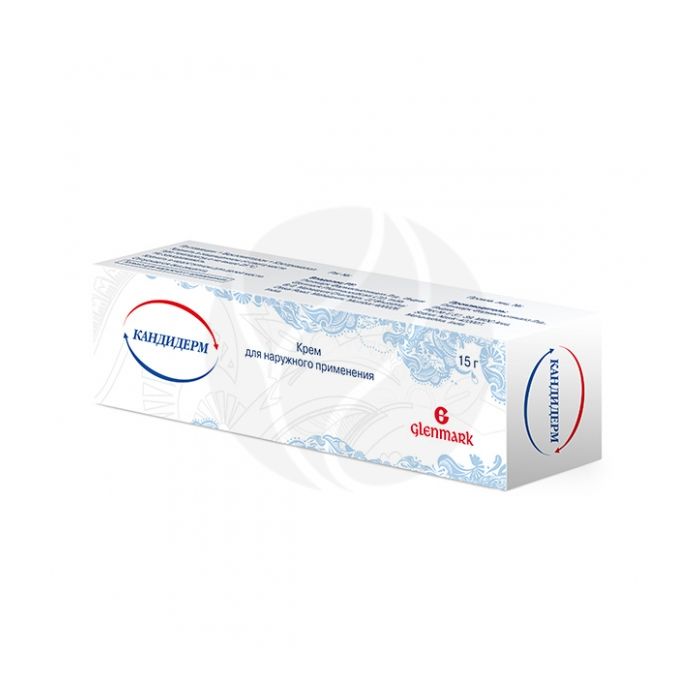Candiderm cream, 15 g
Expiration Date: 05/2027
Russian Pharmacy name:
Кандидерм крем, 15 г
Dermatoses complicated by secondary infection;
athlete's foot;
dermatomycosis (including localization in the groin area) caused by pathogens sensitive to the drug.
Outwardly, apply a thin layer to the affected skin 2 times a day (morning and evening). The duration of treatment depends on the effectiveness and tolerability of therapy and is, as a rule, 2-4 weeks (no more).
For children (7-16 years old), the drug is prescribed strictly under the supervision of a doctor, because possible systemic side effects associated with beclomethasone. When using the drug on large surfaces and / or under an occlusive dressing, it is possible to suppress the function of the hypothalamic-pituitary-adrenal system and develop symptoms of hypercortisolism, there may be a decrease in the excretion of growth hormone, an increase in ICP.
Cream for external use, white, homogeneous.
1 g
clotrimazole 10 mg
beclomethasone dipropionate 0.25 mg
gentamicin (in the form of gentamicin sulfate) 1 mg
Excipients: propylene glycol, cetomacrogol, petrolatum, liquid paraffin, benzyl alcohol, methyl parahydroxybenzoate (methylparaben), propyl parahydroxybenzoate (propylparaben), butylhydroxytoluene, sodium dihydrogen phosphate monohydrate, purified sodium hydrogen phosphate.
Hypersensitivity to the components of the drug;
lupus;
cutaneous manifestations of syphilis;
chickenpox;
herpes simplex;
skin reactions after vaccination;
open wounds;
pregnancy;
lactation period;
children up to age 7 years.
pharmachologic effect
Combined preparation for external use with anti-inflammatory, anti-allergic, antifungal and antibacterial action.
Clotrimazole has an antifungal effect by disrupting the synthesis of ergosterol, which is an integral part of the fungal cell membrane. Active against Trichophyton rubrum, Trichophyton mentagrophytes, Epidermophyton floccosum, Microsporum canis, Candida albicans, Malassezia furfur (Pityrosporum orbiculare).
Beclomethasone has anti-inflammatory, anti-allergic, anti-exudative and antipruritic effects. It inhibits the accumulation of leukocytes, the release of lysosomal enzymes and inflammatory mediators, inhibits phagocytosis, reduces vascular tissue permeability, and prevents the formation of inflammatory edema.
Gentamicin is a broad-spectrum antibiotic from the aminoglycoside group that has a bactericidal effect against gram-negative bacteria: Pseudomonas aeruginosa, Enterobacter aerogenes, Escherichia coli, Proteus vulgaris, Klebsiella pneumoniae; gram-positive bacteria: Streptococcus spp., Staphylococcus aureus.
Side effect
Dermatological reactions: burning sensation, hyperemia, erythema, peeling, dryness, maceration, skin atrophy, striae, hypertrichosis, folliculitis, prickly heat, steroid acne, perioral dermatitis, telangiectasia, hypopigmentation, pyoderma, furunculosis.
Allergic reactions: edema, urticaria, allergic contact dermatitis.
Systemic reactions (including suppression of the function of the adrenal cortex) are possible with prolonged use.
Application during pregnancy and lactation
The use of the drug during pregnancy and during breastfeeding is contraindicated.
Application in children
It is contraindicated for use in children under 7 years of age.
In children aged 7-16 years, the drug is used strictly according to indications and under the supervision of a physician.
special instructions
The drug is not used in ophthalmology.
It is contraindicated to apply to the skin in the eye area.
In order to increase the effectiveness of therapy, it is possible to use occlusive dressings. It should be borne in mind that this increases the transdermal absorption of beclomethasone and gentamicin, which leads to an increased risk of developing systemic side effects.
If a persistent bacterial or fungal microflora appears, the drug should be discontinued and appropriate therapy should be prescribed.
The development of cross-resistance with aminoglycoside antibiotics is possible.
Use in pediatrics
For children, the drug is prescribed only on strict indications and under medical supervision. possible systemic side effects associated with beclomethasone. When using the drug on large surfaces and / or under an occlusive dressing, it is possible to suppress the function of the hypothalamic-pituitary-adrenal system and develop symptoms of hypercortisolism; there may also be a decrease in the excretion of growth hormone and an increase in intracranial pressure.
Overdose
Symptoms: weight gain, edema, arterial hypertension, glucosuria, hypokalemia (symptoms of hypercortisolism).
Treatment: symptomatic therapy, if necessary, correction of the electrolyte balance. A gradual withdrawal of the drug is recommended.

